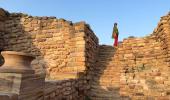Jorhat has many attraction to offer for the discerning and offbeat traveller, discovers Mudit Jain.

Jorhat was the last capital of Assam's Ahom kingdom.
It is surrounded by tea estates and is close to the Hoollongapar Gibbons Sanctuary which contains the only arboreal ape in India amongst other primates.
Jorhat is also close to Majuli, the largest river island in the world.
Most tourists traveling to Assam visit Guwahati and the famous Kamakhya temple, one of the Shakti-peeth temples in India, and the Kaziranga sanctuary, home of the one horned rhinoceros.

Assam has numerous wildlife sanctuaries, the most famous being Kaziranga and the Manas sanctuary.
Apart from tigers, leopards and other wildlife, Kaziranga is famous for the one horned rhinoceros and also hornbill birds common to Assam.

The Tocklai Tea Research Institute, founded in Jorhat in 1911, is the world's oldest and largest tea institute.
The silk worm industry is also well established in Assam.
Muga, also called golden silk, is the most expensive and prized silk in Assam.
Jorhat is surrounded by tea estates and we stayed in the Gatoonga tea estate which now houses two British styled bungalows converted into hotels in the midst of the tea estate.
The bungalows were built in the early 19th century by the British who converted the land into tea estates.
They were later taken over by the Thengol Barooahs who converted them into hotels restoring them to their old world charm.
The two properties on the Gatoonga tea estate can house about 10 to 20 people.





Close to Jorhat town is the Nimati ghat which is the gateway to Majuli.
Majuli is the world's largest river island and one uses ferries to travel across the Brahmaputra river to reach Majuli.
The island is inhabited by various tribes, the largest being the Mising tribe.
Majuli is well known for the establishment of Neo-Vaishnavite culture. This movement helped in the upliftment of backward castes and treated all castes equally.
The Neo-Vaishnavite movement was founded in the 16th century by Sankaradeva who established monasteries called satras on the island.
Sankardeva emphasised personal cleanliness and discarded idol worship giving prime emphasis to chanting the holy names of God.
The practice involves music, singing and dancing to propagate the glory of God.
Majuli, a wetland, is a habitat for various birds including the stork, pelican and Siberian crane.
Majuli has been experiencing heavy soil erosion along its banks and the land area has shrunk by nearly 1/3rd in the last 200 years.
To save the island, the Government of India has been spending huge resources to develop flood gates along the Brahmaputra river to prevent Majuli from being inundated by its waters; an afforestation drive has also been conducted to prevent the soil from being washed away.

At the Kamalabari satra in Majuli young students are provided a gurukul type of lifestyle, taught the holy scriptures as well as a modern system of education.






Another very important satra at Majuli is the Samaguri Satra, which is the epi-centre of mask making in Majuli.
The masks making tradition received an impetus under Dr Hemchandra Goswami, who has dedicated his life to establishing a school to create masks of various sizes from cowdung and bamboo.
Many of the masks made by Dr Goswami and his students are on display all over the world, even in Buckingham Palace in London.


The Hummingbird School was established in 2017 by entrepreneur and educator Bipin Dhane who gave up a well-paying job in Singapore to settle down in Majuli and work for the upliftment of the local tribals.
Initially, the school had 70 children but now has over 300 students and an outreach programme for the community comprising mainly of the Mising tribe.

An hour's drive from Jorhat is the Hoollongapar Gibbon Sanctuary.
It is part of an isolated protected evergreen forest established in 1881 which over the years has shrunk in size being surrounded by tea gardens and villages.
The Hoollongpar sanctuary contains India's only ape and gibbon species, the Hoolock Gibbon, and the nocturnal Bengal slow loris. Other primates in the sanctuary are macaques and langurs.

The apes are arboreal and live in trees seldom descending to the ground.
They have a unique call in which they communicate with each other: "Hoo-koo hooo-kooo".
These gibbons are dimorphic, meaning the adult females and males differ in both colour and size.
The males are larger having black coats whereas the females are smaller and light brown in colour.
Their main diet is fruits but they also feed on leaves and insects as they are frugivores.
They swing from branch to branch using their long adapted forelimbs.
It is important to have continuous cover as the gibbons swing between the trees and any gap in between the trees leads them to come to the ground which makes them vulnerable to prey by other carnivores.
Hoolock Gibbons are listed as an endangered species on the IUCN Red List of Threatened Species and are also protected under the Indian Wildlife (Protection) Act of 1972.
The sanctuary is under further threat of oil drilling near the edge of the sanctuary and also a railway line passing close to it.
They have been many local protests against oil drilling to save the ape species from extinction.

Jorhat has many attraction to offer for the discerning and offbeat traveller and should be a must include destination when visiting the Kaziranga sanctuary, which is around 100 kms away.
Mudit Jain, a former industrialist, is now an investor who spends his time travelling.
Feature Presentation: Ashish Narsale/Rediff.com










